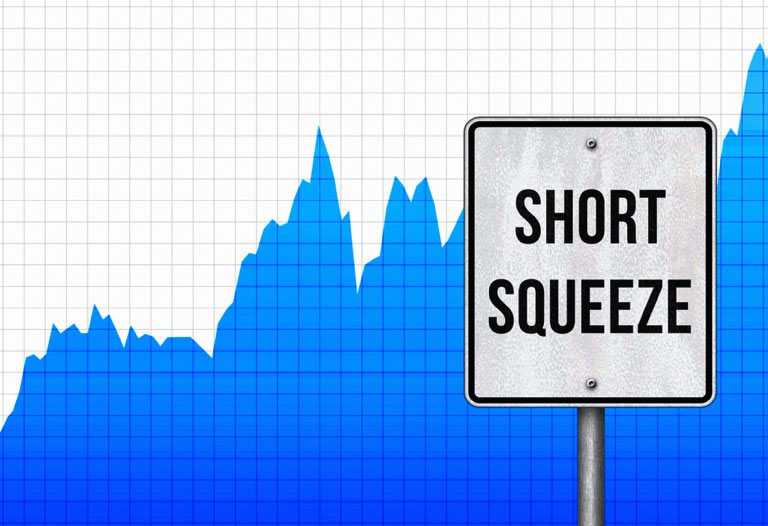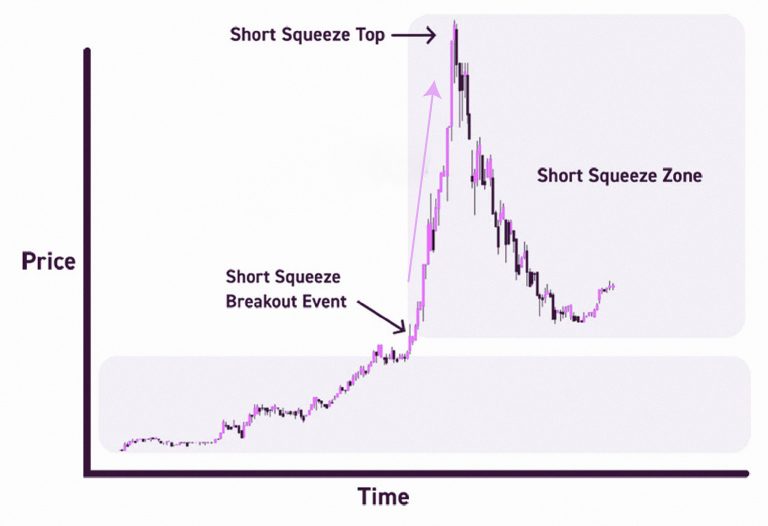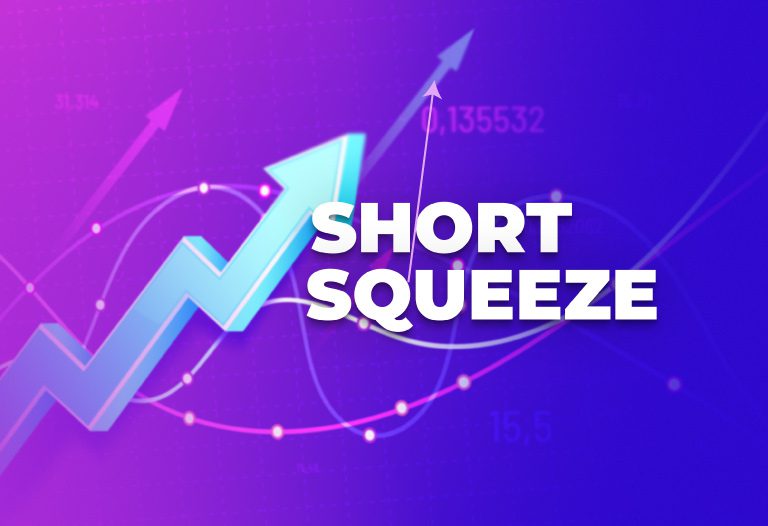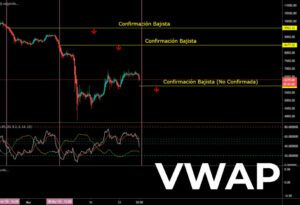
Table of Contents
ToggleOn many occasions, I have mentioned in this blog that the crypto-world feeds off of, or even replicates, traditional finance. For this reason, concepts such as “short squeeze” have become commonplace in our daily conversations.
The cryptocurrency market, beyond the particularities of the technology behind it, is still a market. The prices of the assets listed on it do not escape the terminology and, with logical differences, the traditional movements.
A “short squeeze” may be the reason why the prices of cryptocurrencies are soaring and we perceive them to be accompanied by a large amount of volume.
Let’s get to know this term and understand its implications.
What is a “short squeeze” and under what conditions does it occur?
We are in the presence of a “short squeeze” as market prices, crypto in our specific case, are catapulted with great speed and vertiginously above the estimates that both analysts and traders held prior to this movement.
However, not every precipitous price increase is a “short squezze”. Certain conditions must lend themselves to this type of event. We can list the following.
- The increase in the price or quotation of the asset must be vertiginous.
- The move must be contrary to the majority market sentiment
- This last point must be accompanied by a large number of “short” positions on the asset(s) that show the “short squeeze”.
These are the conditions that must be met, but before continuing, it is necessary to emphasize one concept.
What does it mean to short or “shortear”?
Once again, we find ourselves incorporating vocabulary from the world of traditional finance into our everyday crypto dictionary. Undoubtedly, if you move within the cryptocurrency ecosystem, you will have come across the term “short” and even the verb we have created: “shortear”.
A few lines before, I mentioned that one of the necessary conditions to witness a “short squeeze” is that the amount of “short” positions is significant. What do I mean by this?
The explanation is simpler than it seems. When we are in front of the current price of an asset, we know that its next movements can be three:
- Increasing its price
- Maintain the same price
- Decrease its price
The price will inevitably respond to one of these three possible outcomes. In the trading world, we can bet by opening positions on the first and the last outcome.
So, when after a thorough analysis, a trader believes that the price of an asset will rise, he takes a “long” position. By logical contrast, if this seasoned trader deduces that the probabilities of a fall are higher, he will open a “short” position. With the latter, the larger the price drop, the greater the profit.
Now we can continue with the subject that summons us.
What causes a “short squeeze”?
A “short squeeze” is the pure and exclusive consequence of a dizzying and unexpected increase in the price of an asset. Those traders who have short positions on, in this case, the cryptocurrency whose price is soaring above any forecast, will be forced to abandon their positions in order to reduce their losses.
As a result of this closing of “short” positions, there is an increase in the demand for the cryptocurrency in question and, logically, its supply decreases significantly. This change in the dynamics, previously sustained in the market of this currency, leads to an even more vertiginous price increase and produces the famous “short squeeze”, a concept that could be translated as “strangulation or squeezing of short positions”.
These “strangled” traders, by closing their positions, only contribute to the “strangulation” of their peers. Those who bet from the beginning with their “long” positions, will be the ones smiling at this moment…

How to identify a short squeeze?
Here we will get into the traders’ clothing and get to know some of the tools they use. In order to identify a short squeeze, these market players usually use certain graphic indicators, which allow them to determine which cryptocurrencies are oversold.
When a crypto or any other asset shows excessive selling activity, we could be facing a possible soaring of its price. Here, even if logic tells us otherwise, we could be facing a future increase as a result of manipulation by the big players. They sell an asset in quantity, manage to “scare” the market and buy it furiously when the price adapts to their preferences.
In short, we have well-known indicators to identify “oversold” areas, such as the Relative Strength Index (RSI) and the Williams R.
How can these indicators be used to identify a “short squeeze”?
To complete the analysis it is necessary to take into account one more fact, the interest paid for creating “short” positions. Of course, when we create this type of positions there is a fee, known as “funding rate”. And this responds to the simple fact that when we open this position “someone”, i.e. the exchange, is lending us the cryptocurrency we wish to “short”.
Thus, it is possible to match these indicators, the RSI and the Williams R, with the interest in opening “short” positions of a cryptocurrency. Now, how do we interpret the cost of shorting an asset?
- The lower the interest rate, the less agents will find themselves believing that the asset’s price will fall.
- The higher the interest rate, the more traders are betting on lower interest rates.
In short, the “short squeeze” usually surprises the markets. It is when traders are caught off guard that this movement hits with force. It is clear that oversold indicators and a high funding rate are not a full guarantee that a short squeeze will occur.

Examples of short squeeze
When analyzing the world of traditional markets, “short squeezes” have become relatively common events. This movement is usually generated when the sentiments around a company are “bearish” or of low future expectation, sharing the scene with a high perceived price of its shares and a number of important “shorts” positions.
Suddenly, thanks to the specialized media, we find ourselves with unexpected positive news, which changes the sentiment and the supply-demand dynamics of the market with respect to that asset and the “bears” are forced to buy shares in order to close their positions.
One example, which generated an extraordinary amount of noise, is Elon Musk and his beloved Tesla. The year 2020 turned out to be extraordinary for this company and thus also for its share price. By the following year, its great past performance led to a general sentiment of low market expectation and positions betting on the decline of its price grew at a record pace. When Tesla’s Q1 2021 statistics came out beating all expectations, we witnessed a brutal “short squeeze”.
Example from the crypto world
To come across this type of events in our market, we must keep an eye on the Bitcoin derivatives market. In it, positions with a high degree of leverage are used, either betting on its rise or on the fall of the BTC price. These positions are the ones that perish as victims of the concept we are learning today.
Events of this type, in bitcoin, we found in mid-2019 and a repeat in the big “bounce” after the “Black Thursday” crash, a product of the formal start, in most of the world, of quarantines in the wake of the coronavirus outbreak.
Function, philosophy and adoption
Both traditional and crypto markets, in spite of the dangers they present, have their beneficial flip side. It is evident that the crypto-market can bring us great joys, greater than those of the traditional market, but its setbacks are also greater.
Volatility is a key factor when it comes to programming the disbursements we make in this world. It is necessary to understand once and for all that no one has the “famous crystal ball” and that there are no sure bets.
For an event of the caliber of a “short squeeze” to occur, in practice, it is necessary that large capitals are betting that the price of the asset will fall. Once the short squeeze materializes, the market, once again, proves to us that it can remain irrational for longer than we can remain liquid…



